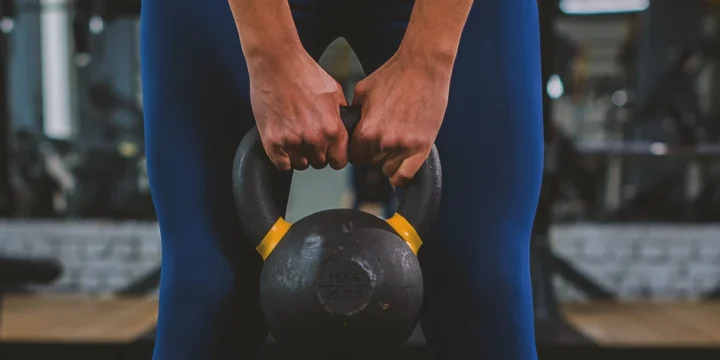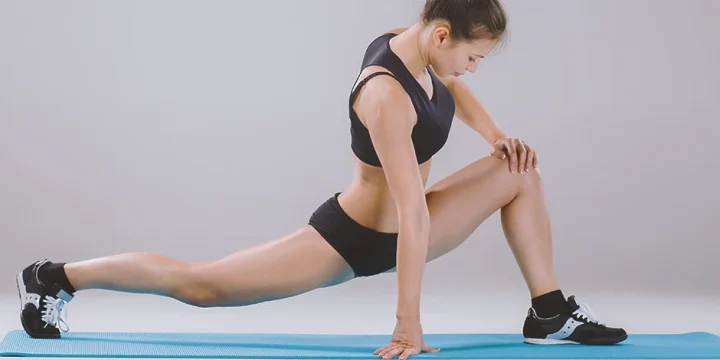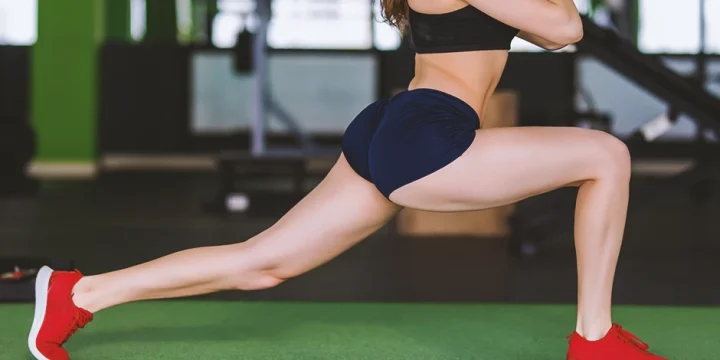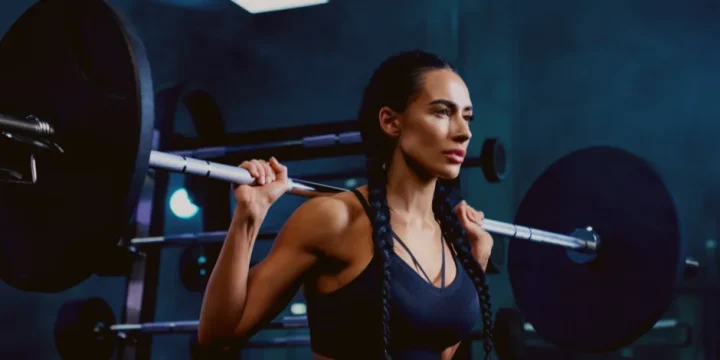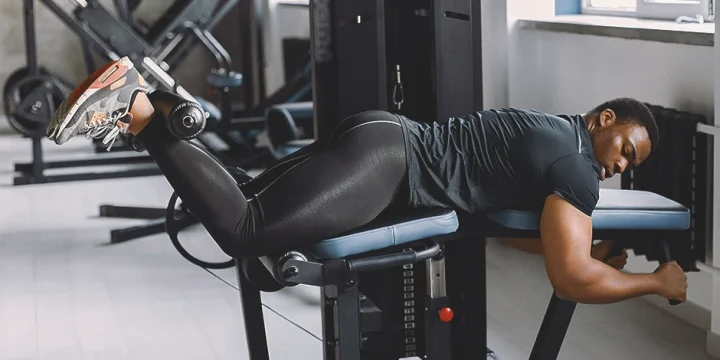With over a decade of experience as a fitness coach, I've experimented with various barbell leg exercises, refining my recommendations based on what works best for my clients.
Recognizing the effectiveness of using a barbell for toning leg muscles, I conducted additional research and gathered insights from fellow experts.
This article compiles all the information, providing you with diverse options to expedite your fitness journey.
Quick Summary
- The best barbell leg exercises for developing strong lower body musculature include back squats, lunges, and deadlift variations.
- Prioritize compound barbell exercises at the beginning of your workout and save isolation and single-joint exercises for the end.
- According to the National Institute of Health, single-leg squats strengthen side muscles (gluteus medius), while rear-foot elevated split squats are better for targeting the back of your thighs (hamstrings).
- As a fitness trainer, I recommend warming up before engaging in barbell leg exercises and taking pre-workout supplements to enhance the overall effectiveness of the lower body workout.
14 Best Barbell Leg Exercises

After testing these exercises, I think they are the best for building leg muscles, emphasizing the importance of beginning with lighter loads to avoid injuries.
Here is the list of the best barbell leg exercises I regularly implement into my workouts.
1. Barbell Front Squat
The Barbell Front Squat is a great lower-body exercise that targets the core and activates muscles like the quadriceps, glutes, hips, and hamstrings.
Here's how to do it:
- Step up to the rack, placing the bar close to your chest but not touching your neck.
- Take a shoulder-width grip with your hands, ensuring your elbows face forward and up.
- If needed, place two fingers under the bar.
- Unrack the bar, step back with a slightly wider than hip-distance foot placement.
- Lower into a deep squat.
- Return to the starting position by extending your hips and knees.
2. Barbell Back Squat
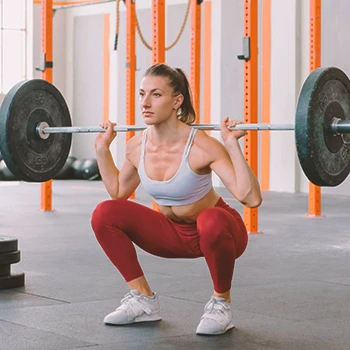
The back squat is one of the essential big three lifts, along with deadlifts and bench presses, activating key muscles like the lower back, glutes, quads, and hamstrings.
Here's how to do it:
- Stand with your feet shoulder-width apart.
- Slide under the barbell, placing it on your upper back, and use your arms to balance without sliding.
- Take a step back, slightly bending your knees to avoid hyperextension.
- Find a comfortable position to lower into a deep squat.
- Slowly bend your knees and hips until your thighs are parallel to the floor.
- Hold for 1 second, then raise back up to a standing position with slightly bent knees.
Also Read: Best Barbell Shoulder Exercises
3. Front Racked Barbell Reverse Lunge
The Front-Racked Barbell Reverse Lunge is a dynamic lower body exercise that challenges adductor muscles and targets quads, glutes, hamstrings, and the adductor complex for stability during backward lunges.
Here's how to do it:
- Load a barbell on the rack and place it on your upper back.
- Lift the barbell, step back, and slightly bend your knees.
- Lunge backward with your right leg, bending the left knee and hip simultaneously.
- Stop when your right leg is just above the floor, and your left thigh is almost parallel to the ground.
- Push with your right foot to return to the starting position, engaging the quads and glutes of your left leg.
- Repeat with the other leg.
4. Barbell Split Squat
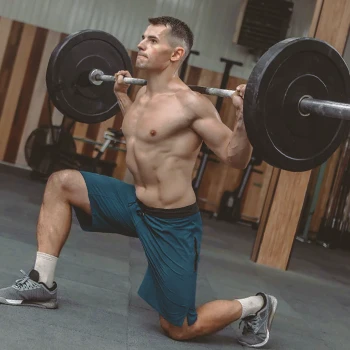
The Barbell Split Squat is a semi-unilateral squat that challenges stabilizers and single-leg strength, activating muscles like quads, hamstrings, glutes, core, and adductor magnus for stability.
Here's how to do it:
- Load the barbell on your upper back with appropriate weight.
- Step backward, maintaining a stable frame, with feet shoulder-width apart.
- Step back with your right foot, remaining in the split position.
- Lower yourself by bending your front (left) leg and hip.
- Stop when your right knee almost touches the ground, and the thigh of your left foot is parallel.
- Hold for 1 second and return to the starting split squat position.
- Repeat with the same leg, then switch.
5. Barbell Good Morning
Barbell Good Mornings are challenging, targeting posterior chain muscles like glutes, hamstrings, and back (erector spinae).
Here's how to do it:
- Place the barbell on your back with hands slightly wider than squatting.
- Take two steps back for space.
- Brace your abdominals and upper back, inhale deeply.
- Bend hips forward while keeping knees fixed.
- Hinge until your upper body is parallel to the floor.
- Exhale and slowly return to the starting position.
6. Barbell Hip Thrust
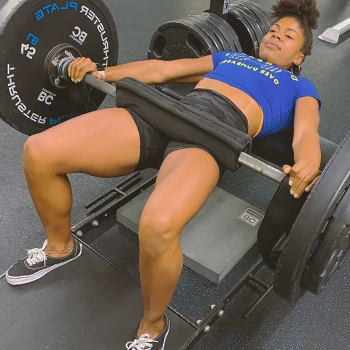
The Barbell Hip Thrust, a glute bridge variation, targets the lower body's posterior chain, challenging your glutes and hamstrings when performed correctly.
Here's how to do it:
- Sit on the floor with bent knees, feet wider than hip distance apart.
- Turn toes out slightly and rest upper back against the weight bench.
- Place the barbell across hips, holding it in place without using your arms.
- Squeeze posterior chain leg muscles, glutes, and hamstrings, pressing the bar straight up.
- Hold for 1 second and lower slowly without touching the floor.
- Repeat for the desired number of repetitions.
“By training the ‘non-mirror’ muscles — the glutes, hamstrings, calves, and back — you get the most bang for your buck when it comes to performance.”
- Todd Durkin, Strength Coach & Owner of Fitness Quest 10
7. Barbell Romanian Deadlift
The Barbell Romanian Deadlift is effective for developing the gluteus maximus, hamstrings, and erector spinae, often used for beginners not ready for traditional deadlifts.
Here's how to do it:
- Load the barbell on the floor, hands slightly wider than shoulder-width apart.
- Bend knees slightly to avoid hyperextension.
- Drive hips backward, bending torso forward, sliding the barbell in front of your body.
- Stop when hands pass below the knees, holding for one second.
- Slowly reverse the motion, returning to the starting position without rounding your back or bending/extending the knees.
8. Barbell Low Rack Pull
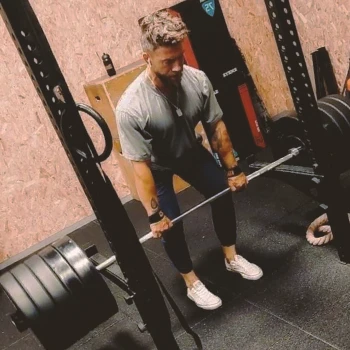
The barbell low rack pull is similar to a Romanian deadlift but starts from the rack and activates some additional muscles. It's excellent for developing lower-body posterior chain muscles and upper-body muscles such as the lats and traps.
Here's how to do it:
- Set the rack just below or above knee height.
- Load the barbell on the rack with the appropriate weight.
- Step up to the bar, bending knees and hips slightly (feet shoulder-width apart).
- Grasp the bar just shoulder-width apart with a double overhand grip.
- Lift the barbell, extending hips and knees simultaneously.
- Hold the top position for 1 second and return to the starting position without dropping the bar on the rack.
9. Sumo Deadlift
Sumo deadlift may be the best deadlift variation for building your adductor strength. The wide stance allows easier lowering while working your quads, glutes, hamstring, and inner thighs.
Here's how to do it:
- Load the bar on the floor with the appropriate weight.
- Place your feet in front of the bar, shins close to it.
- Hold the barbell with an alternating grip at shoulder width.
- Straighten your back, activate your abdominal muscles, and lift the barbell by extending hips and knees simultaneously.
- Keep elbows straight during the upward motion.
- Finish in the top position, holding for 1 or 2 seconds, and slowly lower the bar to the floor by reversing the movement.
10. Barbell Standing Calf Raise
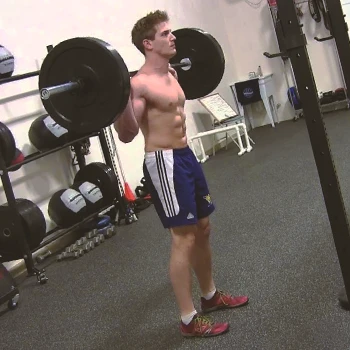
The Barbell Standing Calf Raise is an accessory lift suitable for the end of workouts or during rest intervals, targeting calf muscles, including the soleus and gastrocnemius.
Here's how to do it:
- Place the barbell on the rack, loading the appropriate weight.
- Slide below the barbell, positioning it on your upper back.
- Take a small step back, standing tall to support the barbell without losing balance, toes facing forward.
- Raise both heels, contracting calf muscles on each leg.
- Maximally extend your ankle joint (maximal plantar flexion) and hold for 1 second.
- Slowly return to the starting position, minimizing time on the floor with your heels.
11. Barbell Walking Lunges
Barbell Walking Lunges are a functional exercise for lower body strength, challenging joints with dynamic stabilization
Here's how to do it:
- Place the barbell on the rack, loaded with weight plates.
- Put the barbell on your back and find an open space for up to 16 uninterrupted steps.
- Begin lunging forward with your right leg until your left knee is 1 inch above the floor.
- Transition with your left leg, lunging forward, and repeat for the desired repetitions.
12. Barbell Side Lunges
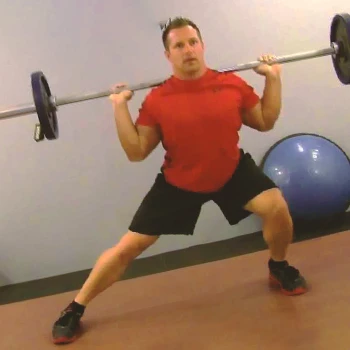
The Barbell Side Lunge is a lower body exercise targeting the frontal plane, often overlooked in workout programs, effectively working quads, glutes, hamstrings, abductors, and adductors.
Here's how to do it:
- Place the barbell on the rack, loading weights on your upper back.
- Step back from the rack with both feet.
- Take a shoulder-width stance, laterally lunging with your right leg while keeping core tight and back straight.
- Lower yourself until your right thigh is parallel to the ground.
- Hold for 1 or 2 seconds and return to the starting position.
- Repeat, alternating legs.
13. Barbell Single Leg Deadlift
The Barbell Single-Leg Deadlift is a key unilateral posterior chain exercise, enhancing stability in ankle, knee, and hip joints for plyometrics and reactive exercises.
Here's how to do it:
- Place the barbell on the floor, loaded with weight plates.
- Lift the barbell without rounding your back.
- Shift balance to the right leg, bending your hip forward, extending the left leg backward and up.
- Maintain proximity of the barbell to the body during the lowering phase, sliding on its surface.
- Lower the barbell below knees, pause for 1 second.
- Reverse the process, extending your hip and lowering your left leg to the starting position.
14. Barbell Step-up
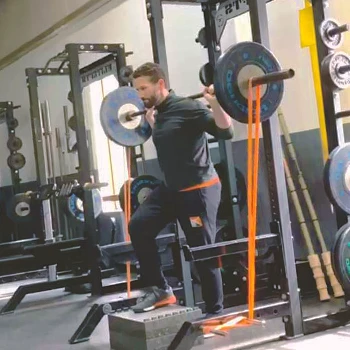
The Barbell Step-Up is a unilateral lower-body exercise targeting both anterior and posterior chain muscles.
Here's how to do it:
- Load the barbell on the rack and place it on your upper back for balance.
- Place your right foot on the box, pushing through your heel to lift to the top position, bringing your left foot onto the platform simultaneously.
- Reverse the process by stepping back down with your right foot, followed by the left.
- Repeat for the desired repetitions on one leg, then switch to the other.
Warming Up for Barbell Leg Exercises

Warming up our body before an activity is essential since our muscle fibers can stretch and contract better when our bodies' temperature increases.
To warm up for barbell leg exercises, follow these steps:
- Raise Body Temperature: Spend 3 minutes on a treadmill, elliptical, or engage in rope jumping to increase your body's temperature. This helps muscles contract easily and improves joint range of motion.
- Dynamic Warm-Up: In a space of about 8 meters, perform exercises like carioca, side shuffle, backpedal jog, walking knee to chest, lunge walk with a twist, heel-to-rear jog, straight leg kick, and power skip. Perform each exercise once or cover the length of the space.
- Activation: Complete 2 sets of 8 repetitions with minimal rest between the following exercises: single-leg floor hip thrust, quadruped hip abduction, dead bug.
Over my years of working with clients, I consistently recommend raising their body temperature through a dynamic warm-up and muscle activation to prepare for our barbell exercises.
“In as little as 5 to 15 minutes, you can increase blood flow, send oxygen to the working muscles, prepare your muscles and nerves for an upcoming effort, improve range of motion, and most importantly, prepare your mind for the workout ahead.”
- Marni Sumbal, Exercise Physiologist & Founder of TriMarni Coaching & Nutrition
Barbell Programming Suggestions

Programming your exercises and deciding upon the intensity, the number of sets and reps, and rest intervals is challenging.
All these factors will affect your end goal, which can be hypertrophy, endurance, strength, power, or something similar.
According to the National Institute of Health, poor exercise selection and order can affect workout performance and sometimes even increase the chance of injury [1].
Related Articles:
Exercise Order
Consider movement patterns, muscle group activations, and joints when deciding exercise order.
Place compound exercises at the beginning and isolation exercises at the end, prioritizing multi-joint movements first and single-joint movements later.
Alternate between movement patterns and joints used; for instance, follow deadlift variations with squat variations due to their distinct movement patterns—one more hip-dominant, the other knee-dominant.
As a fitness trainer, I recommend incorporating these principles into my clients' workout routines to structure them logically and coherently.
Barbell Sets & Reps for Strength
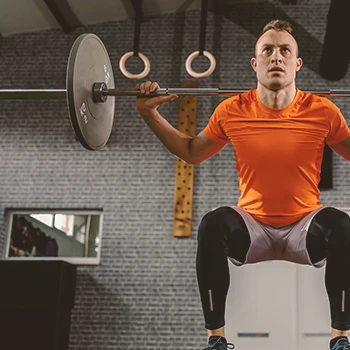
Keep your reps below 6 for optimal strength development, focusing on the 1-6 repetition range for maximal leg muscle strength. Aim for 3-5 sets, considering factors like freshness, fitness level, and soreness. Schedule strength workouts after adequate nutrient intake and rest, as per the National Institute of Health [2].
Barbell Sets & Reps for Muscle
For muscle hypertrophy, target 6-12 repetitions. Perform 2-5 sets of 12 repetitions for each exercise, minimizing rest between sets, preferably not exceeding 90 seconds.
Sample Barbell Leg Workout

Here is a sample barbell leg workout:
- Barbell Back Squat
- Barbell Hip Thrust
- Barbell Split Squat
- Barbell Romanian Deadlift
- Barbell Calf Raises
With my experience as a fitness trainer spanning many years, I personally recommend performing these exercises in the provided order, completing 2 sets of 8 repetitions each, with a rest of 90 seconds in between.
"Adding leg exercises to your routine allows you to focus on muscle groups that get underworked and neglected during your daily life, sports or other exercise. Strengthening these muscles can help you to prevent imbalances."
- Josh Lewis, NSCA Personal Trainer
FAQs
Are Barbell Squats the Best Leg Exercise?
Yes, barbell squats are the best leg exercise. This is because barbell squats effectively target all your quadriceps and posterior muscles, such as the glutes and hamstrings.
What Is the King of Leg Exercises?
The king of leg exercises is squat. However, the king of all workouts is considered a deadlift due to its high demand on the whole body.
What Is Better Than a Barbell Squat?
Lunges are better than a barbell squat. Lunges are a more functional lower-body exercise that will challenge your adductor muscles and have a more significant carryover to your daily activities.
Do Barbell Squats Build Big Legs?
Yes, barbell squats build big legs. In addition, barbell squats will activate muscles such as your quadriceps, glutes, and hamstrings, which build most of your lower body musculature.
References:
- https://www.ncbi.nlm.nih.gov/pmc/articles/PMC8139277/
- https://www.ncbi.nlm.nih.gov/pmc/articles/PMC7927075/
About The Author
You May Also Like

